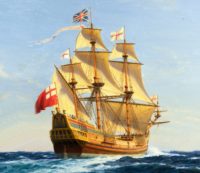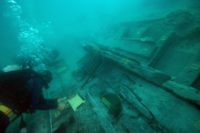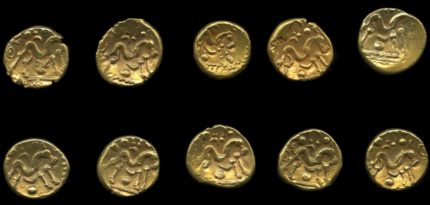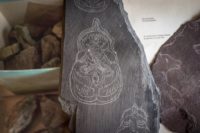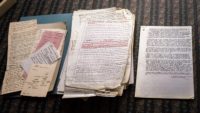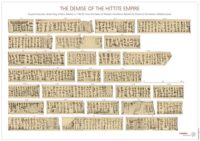An archaeological excavation on a cliff overlooking Windwick Bay in South Ronaldsay, Orkney, has discovered the remains of an Iron Age feast of gut-busting dimensions and the party favors were top-notch. The site, known as The Cairns, contains the remains of an Iron Age broch, a circular multi-story tower with thick stone walls forming a massive defensive structure. The dig is an ongoing project of the University of the Highlands and Islands Archaeology Institute which has been exploring different aspects of the broch complex every field season since 2006.
Found in North Scotland, both mainland and island, brochs were in use from around 600 B.C. through the 2nd century A.D. Radiocarbon analysis dates the demise of The Cairns broch to the mid-2nd century. Settlements often sprang up around a broch, and The Cairns is no exception. The remains of several buildings have been found right up against the defensive walls, and the close integration of village and tower suggest that the settlement was planned from the time the broch was constructed rather than a later ad hoc development.
Even after the broch fell into disuse and then ruin, the site’s structures were either demolished and new ones built over them, or repurposed in whole or in part. The entrance chamber to the broch, for example, became part of a souterrain. One of the broch village buildings, Structure K, was derelict and had no roof when it was used for the production of metal jewelry on a large scale during a single event.
Dig director Martin Carruthers:
The remains of this episode include furnaces, bronze waste; bronze splashes and droplets, crucibles, and very significantly: moulds for casting fine bronze objects. Over sixty moulds and mould fragments have been recovered. These were used to cast a variety of objects ranging from simple bronze rings, to distinctive decorated dress pins, called ‘projecting ring-headed pins’, and penannular brooches, which are the lovely open-ring, cloak brooches that are sometimes referred to as ‘Celtic’ brooches.
The volume and nature of the items being produced suggests that this was a socially significant collection of prestigious items aimed at denoting the identity, and status of those who were to wear the items; badges of their belonging and importance within the community. Importantly, it is the entire suite of materials found together, as well as their precise distribution pattern within the trench, that indicates strongly that this material relates to an in situ metalworking event, rather than a secondary event, such as merely the refuse disposal of old moulds, or even their ritual deposition.
 Radiocarbon dating found that this event took place between the mid-3rd and mid-4th century A.D., after the demise of the broch. Adjacent to and overlapping the metalworking area in Structure K, the team unearthed a midden replete with animal bones. The remains of more than 10,000 animals, domesticated cattle, sheep and pigs as well as red deer, otters and horses, were discarded on this spot. Extensive evidence of cooking — carbonized soil, ash, fire-cracked cobbles used to heat up water in pots — was also found in the midden, as were some crucibles and metalworking moulds that connect the metalworking event and this gargantuan party.
Radiocarbon dating found that this event took place between the mid-3rd and mid-4th century A.D., after the demise of the broch. Adjacent to and overlapping the metalworking area in Structure K, the team unearthed a midden replete with animal bones. The remains of more than 10,000 animals, domesticated cattle, sheep and pigs as well as red deer, otters and horses, were discarded on this spot. Extensive evidence of cooking — carbonized soil, ash, fire-cracked cobbles used to heat up water in pots — was also found in the midden, as were some crucibles and metalworking moulds that connect the metalworking event and this gargantuan party.
Martin Carruthers explains the significance and potential meaning of this connection:
The close stratigraphic association between the fine metalworking and the feasting raises the question of what exactly was going on here. One possibility that I like very much is that the feasting could be the spectacular social event at which the products of the jewellery-making were handed out, or gifted, to their intended recipients by those who had sponsored the metalworking in the first place. We may therefore be peering into the social circumstances of the jewellery-making and the distribution of its products amongst the community at The Cairns. If this is so, then it is a fascinating insight into the moment at which objects like the pins, brooches and rings started off on their biographies, their journey through people’s lives.
This is a very rare opportunity to see more clearly the initial nature of the social and political significance of these objects from their start-point. It would mean that the sharing or gifting of the jewellery was surrounded in the circumstances of a big social occasion, a massive party, if you like. We are seeing their birth and the important role they played in the power-play and social strategies of Iron Age groups and individuals. With the circumstances of the jewellery-making we are able, for once, to investigate the intended status and significance of these items within the context of their birth, rather than depending on the information we usually get, which is based on the discovery of these objects much later in their lives, in fact at the end of their lives, when they went in the ground, perhaps many decades, or more, after they were originally made and worn. Most theories about the brooches and pins and their role in society have been based on what we glean from them in this end-state, but the assemblage of metalworking evidence from The Cairns; the moulds, crucibles, and other items, together with the massive remains of the feasting allows us to grasp what was going on at the point in time when these jewellery items were instigated. […]
At one level, perhaps, everyone in the community was involved in the feasting, but only some were ennobled by receiving a pin; a ring, or a brooch. So it may well be that we are looking at the strategies for creating and maintaining the concept of the entire community at the same time as signalling social difference, and hierarchy within the community of this post-broch period. If so, the excavations are really coming up trumps in terms of allowing us to peer into the social circumstances of Iron Age communities.
